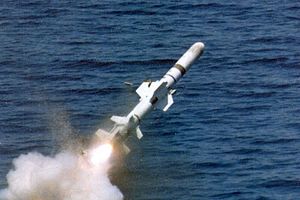The U.S. Navy will conduct a live fire test of a Harpoon anti-ship missile aboard the Independence-class Littoral Combat Ship (LCS) USS Coronado during the Rim of the Pacific Exercise (RIMPAC) in July, IHS Jane’s Missiles & Rockets reports:
The U.S. Navy (USN) is to fit the Boeing RGM-84D Harpoon Block 1C surface-to-surface guided weapon system onto an Independence variant littoral combat ship (LCS) for an operational test aligned to the new concept of ‘Distributed Lethality’ now being promulgated by the navy’s surface warfare leadership.
RIMPAC is the world’s largest international maritime warfare exercise held biennially in June and July of even numbered years. The naval drill is administered by the U.S. Navy’s Pacific Fleet, headquartered at Pearl Harbor, Hawaii, and other U.S. government entities including the U.S. Marine Corps.
First introduced in 1985, the Boeing RGM-84D Harpoon Block 1C is a subsonic, surface-launched anti-ship, all weather cruise missile equipped with an autonomous active radar seeker and a selectable pop up or sea skimming mode. It has a range of 150 kilometers (93 miles) and a top speed of Mach 0.9.
The U.S. Navy is seeking to equip the LCS with a new over-the-horizon missile by the end of 2016 (See: “US Navy Wants New Missile for Littoral Combat Ship by End of 2016”). Naval warfare experts are currently examining what weapons system would be the best fit for the LCS.
As I explained previously, the U.S. Navy still lacks an suitable long-range, anti-surface weapon to implement a re-organization of its surface fleet based on the “distributed lethality” concept (see: “The US Navy’s New Surface Warfare Strategy: “Distributed Lethality”):
The Norway-based Kongsberg Gruppen arms supplier and the U.S. missile manufacturer Raytheon have joined forces to try to convince the navy to acquire the fifth-generation over-the-horizon Kongsberg Naval Strike Missile (NSM) for the LCS.
Boeing Defense, Space & Security (BDS) also announced in April 2015 that it will offer an updated version of the Harpoon RGM-84 Block II anti-ship missile (ASM), called Harpoon Next Generation to the U.S. Navy.
In comparison to the RGM-84D Harpoon Block 1C that will be tested during RIMPAC 2016 in July, the Harpoon Next Generation will have an increased range, a more fuel-efficient engine, and a smaller 136-kilogram (300 pound) warhead.
The Pentagon decided to rebrand both LCS classes as frigates and is consequently looking to increase the vessels’ firepower. All in all, the U.S. Navy plans to field a total of 40 LCS over the next few years.
































